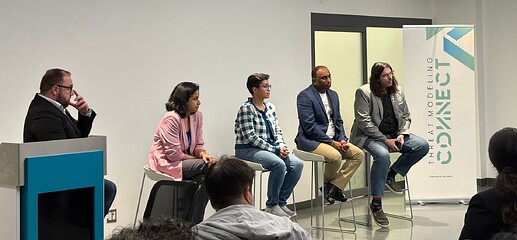Event Recap: From Awareness to ROI — How Threat Modeling Shapes the Future of Security
The September 2025 Threat Modeling Connect session, “From Awareness to ROI — How Threat Modeling Shapes the Future of Security,” brought together security leaders and practitioners to explore how organizations can transform threat modeling from a technical process into a business value driver.
The event began with Owen, who kicked things off with a warm welcome and introduction, setting the stage for an engaging discussion. Emmanuel then took over as moderator, leading a panel featuring Parul, Mina, Mark, and Jamil.
The discussion began with the core question: Why is threat modeling important?
• Parul emphasized embedding security early in the development lifecycle—shifting left to reduce risks before they escalate.
• Mina highlighted how threat modeling enables better budgeting, reduces rework, and saves time and money.
• Mark used the analogy of building a house—threat modeling acts as the blueprint that guides teams throughout the project.
• Jamil reinforced that collaboration across engineering and security is key to long-term success.
When addressing the biggest challenge in gaining buy-in, the panel agreed that demonstrating tangible value is critical. Parul stressed showing how threat modeling prevents misconfigurations (like misplaced firewalls) and reduces potential attack surfaces. Mina added that tying findings to cost savings resonates with business leaders.
The conversation naturally shifted to ROI and business alignment. Mina advised “talking numbers”—quantifying risk reduction and potential loss to communicate impact. Mark noted that translating technical insights into business language bridges the gap between engineers and executives.
The panel also explored the role of AI in threat modeling. Mina noted that AI can enhance visibility—“we cannot protect what we cannot see”—while Parul added that automation and GenAI can accelerate investigations and analysis when applied thoughtfully.
When discussing the future of threat modeling, Jamil observed that awareness and leadership buy-in have significantly improved in recent years. Organizations are moving toward structured, repeatable approaches that continuously evolve with business needs. Mark emphasized the importance of knowledge sharing and documentation to ensure continuity when teams change.
To wrap up, Emmanuel’s rapid-fire round captured each panelist’s key takeaway:
• Parul: Threat modeling is cost-effective and foundational.
• Mina: Be fair and strike early—start threat modeling before incidents happen.
• Mark: It’s like an annual health check for your systems—preventive, not reactive.
• Jamil: Use innovation and communication to make threat modeling persuasive and actionable.
Emmanuel wrapped up by thanking the audience and giving a special shoutout to the volunteers who helped make the event a success. He also encouraged attendees to continue the conversation at the upcoming virtual October event, “Threat Modeling Together – Americas.”
Networking & Refreshments
Followed up with a networking session with free refreshments
As we look ahead, the upcoming Threat Modeling – Americas session will continue the conversation, diving deeper into real-world applications and emerging trends.
Article by Samira Parveen


